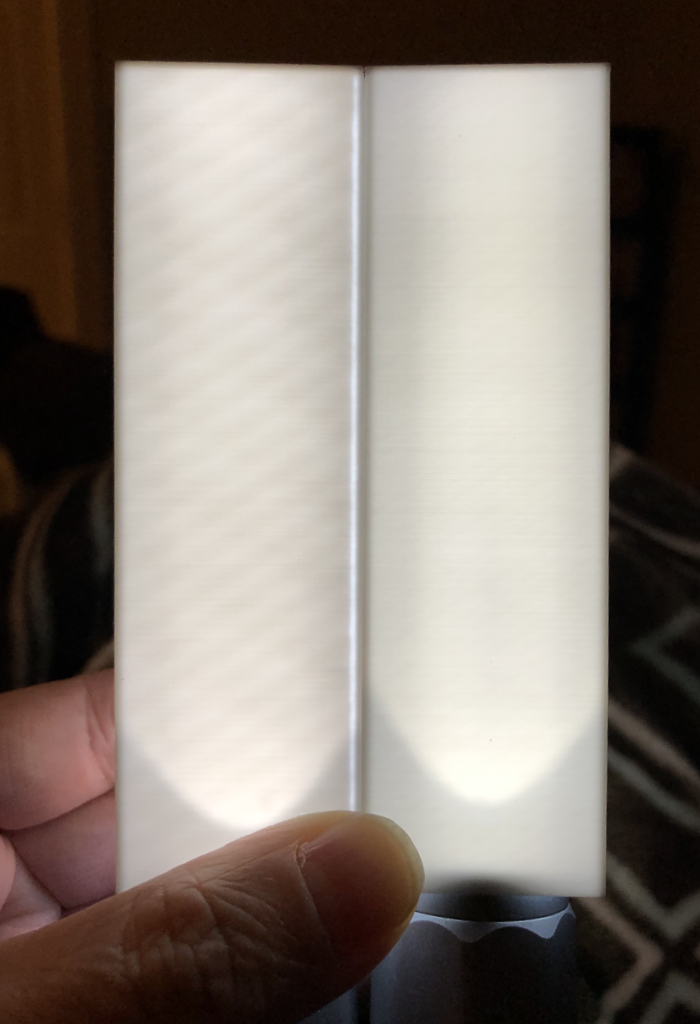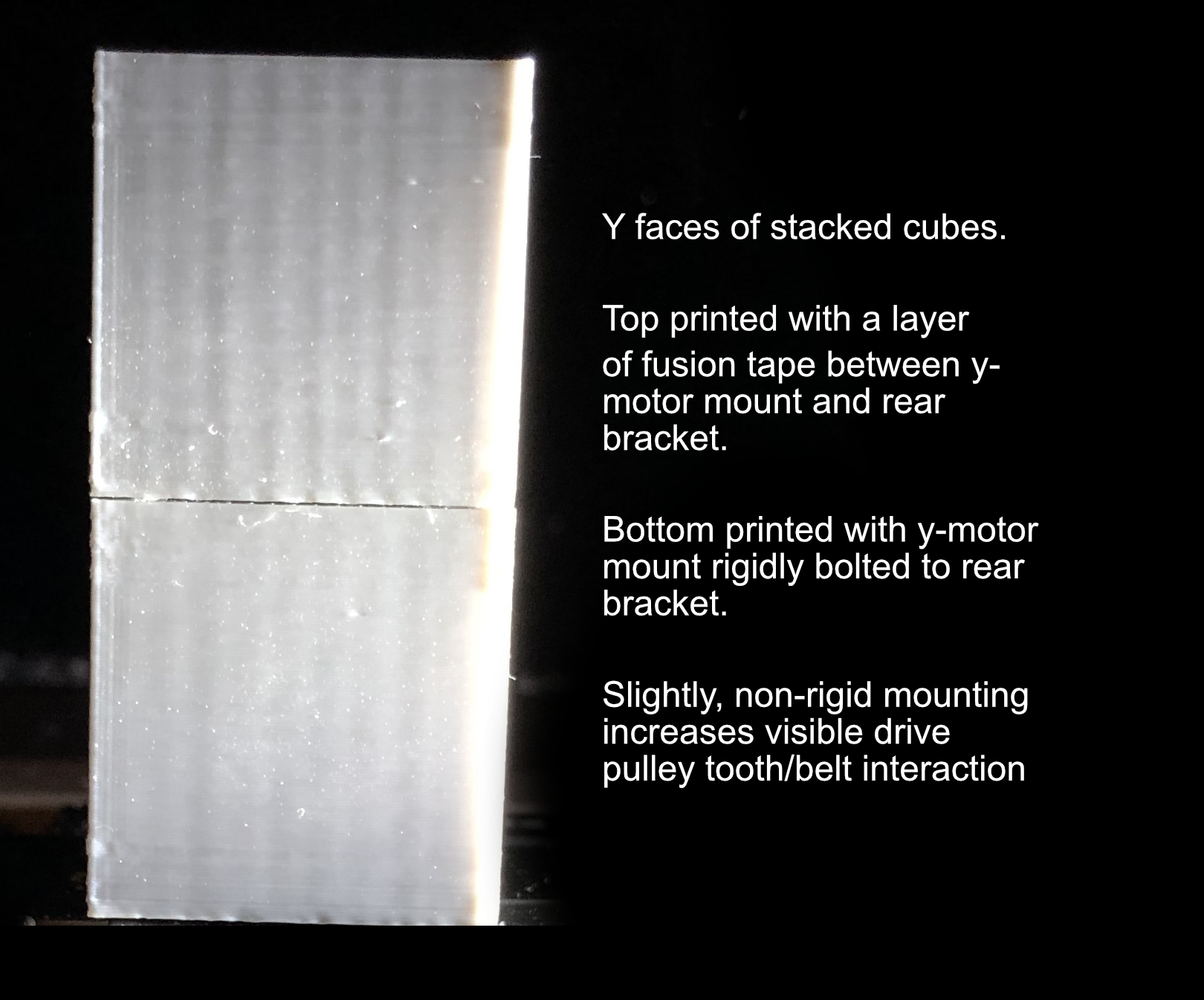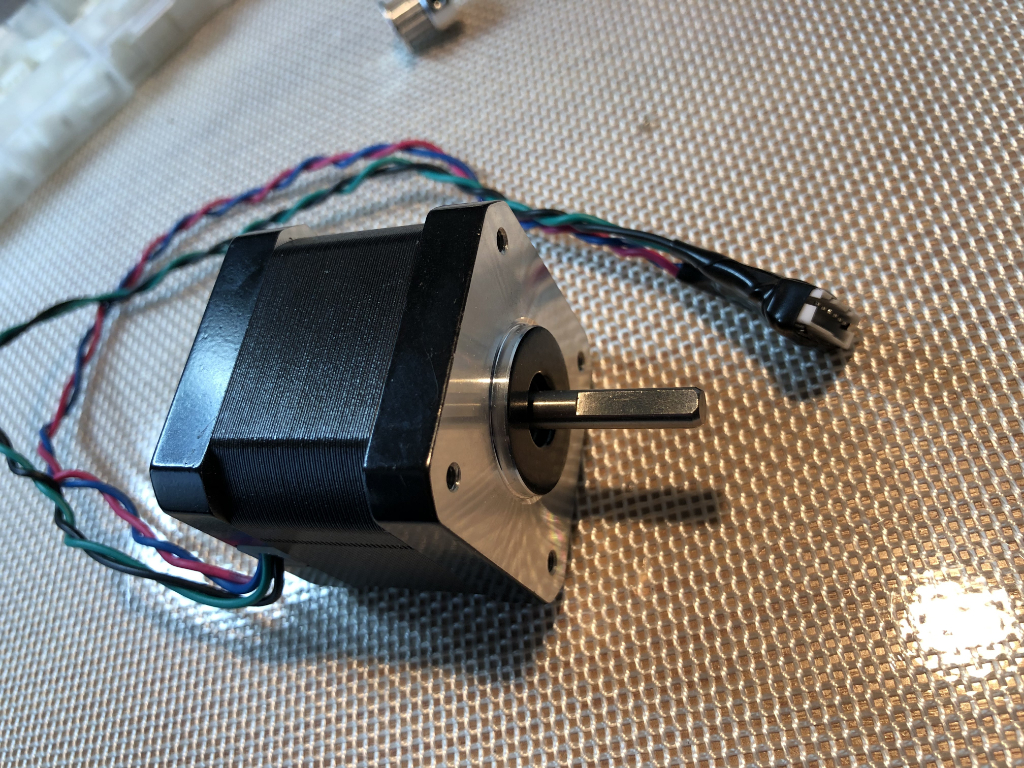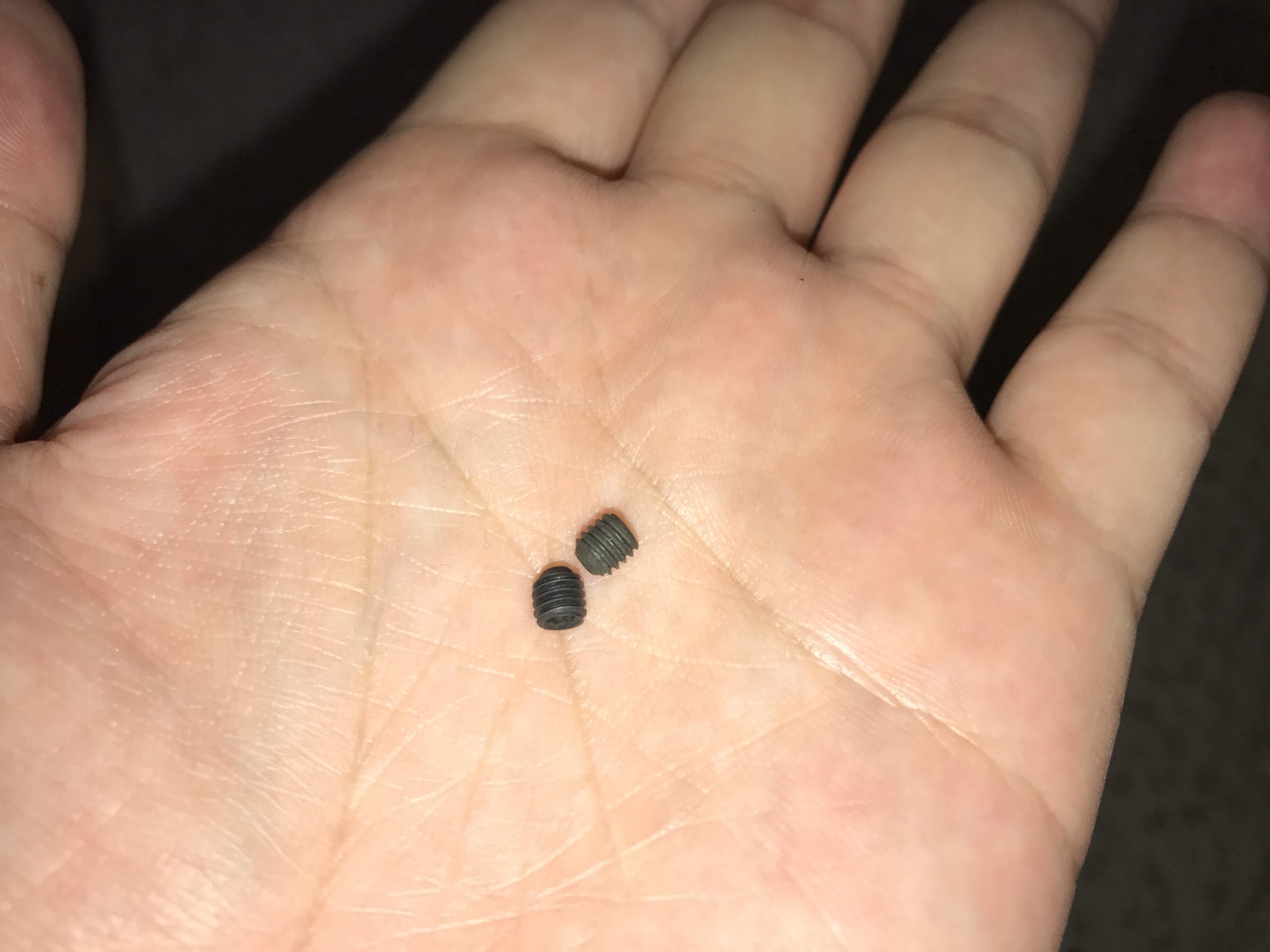Re: Stepper Motor Upgrades to Eliminate VFA's (Vertical Fine Artifacts)
Yes, it would be good if lower cost motors can work as well. One of the Stepper Online units will arrive in a few days. The more choices we find the better.
I had to raise the limits for the maximum step frequency in the firmwar
That matches what I see on the Stealthchop waveform during faster moves. It becomes a triangular wave.
I found within Configuration_adv.h in the Prusa firmware.
#define MAX_STEP_FREQUENCY 40000 // Max step frequency for Ultimaker (5000 pps / half step). Toshiba steppers are 4x slower, but Prusa3D does not use those.
//By default pololu step drivers require an active high signal. However, some high power drivers require an active low signal as step.
That figure is already much higher than 16K.
I'm surprised a shorter motor worked. Good to know. Also widens the field. Now I must find a way to create a velocity tower to check how the motors work at varying speed as tower height increases. That will get another aspect more easily tested.
Like Dreide said, so much of what I am seeing actually work does not match what my understanding from the TMC2130 spec sheet predicts.
[edit]
I found reading around that the Rambo is limited to about 10 kHz on its interrupts. Above that rate, Marlin steps have to switch to double and quad stepping.
Also, I stand corrected. Someone DID get a 0.9 running on the extruder. https://shop.prusa3d.com/forum/prusa-i3-kit-archive--f84/0-9-extruder-motor-t5010.html#p36388
Discussion there was about possible retraction speed issues, but it seems to work. Maybe a 0.9 on the extruder TMC2130_USTEPS_E 16 would get the monotonicity improvement of a 0.9 but still be fast enough. Might be doing another extruder tear down after all.
0.9 degree Moons test on extruder
I swapped my motors and to move a 0.9 degree on the extruder and 1.8 on x-axis.
That's the best I can do with just two 0.9 in hand. Putting x back to 1.8 Moon's is least destructive step backwards. If the 0.9 tests out as more uniform than 1.8 on the extruder, it's staying in that position and I will get a new 0.9 for x.
For completeness, my extruder is a direct drive Bear extruder with standard Bondtech gears.
Decreased e-steps for E to compensate for the 0.9 degrees. That leaves it on the same number of steps/mm, but with the higher monotonicity of a 0.9 degree motor.
Loads and unloads filament OK.
Attempting an ecore tower now. We'll see in about two hours what the results are. First layer is looking good.
Re: Stepper Motor Upgrades to Eliminate VFA's (Vertical Fine Artifacts)
I found reading around that the Rambo is limited to about 10 kHz on its interrupts. Above that rate, Marlin steps have to switch to double and quad stepping.
Exactly, it is in stepper.cpp:
if(step_rate > MAX_STEP_FREQUENCY) step_rate = MAX_STEP_FREQUENCY;
if(step_rate > 20000) { // If steprate > 20kHz >> step 4 times
step_rate = (step_rate >> 2)&0x3fff;
step_loops = 4;
}
else if(step_rate > 10000) { // If steprate > 10kHz >> step 2 times
step_rate = (step_rate >> 1)&0x7fff;
step_loops = 2;
}
else {
step_loops = 1;
}
Re: Stepper Motor Upgrades to Eliminate VFA's (Vertical Fine Artifacts)
Probably not touching those limits with them already set so high. The motors are running fine. It would be purely to reduce noise. As it is, I can't hear the printer when I'm in the next room. That I can live with without a problem.
Still running the Moons MS17HA2P4100 0.9º OK on extruder....
Here is an interesting read on the three types of 0.9 degree stepper motors and the effect on step accuracy.
https://www.linengineering.com/resources/white-papers/design-accuracy-comparison-0-9-vs-1-8/
Re: Stepper Motor Upgrades to Eliminate VFA's (Vertical Fine Artifacts)
Still running the Moons MS17HA2P4100 0.9º OK on extruder....
Obviously, your dust filter needs to be upgraded as well to be on a par 😉 : 414 Felt Polishing 1/2" Wheels (OD=12.5mm, ~7mm thick).
Re: Moons 0.9 is vastly superior on extruder
There is no contest at all. The Moons 0.9 on the extruder blows away even a Moons 1.8
This motor is staying on my extruder!
This is good news. Congrats!
So for this tower, has there been anything varied along Z? And what causes the pattern that repeats perpendicular to Z - the HFAs so to speak?
Re: Stepper Motor Upgrades to Eliminate VFA's (Vertical Fine Artifacts)
The tower with Moons' 0.9 on extruder varies waveform power from 0.94 (right in picture) to 1.14 (left in picture)
Best is about power 1.07.
The doubled frequency of the diagonal wave is good evidence that the diagonal wave is tied to the extruder motor e-cycle. Amplitude of the extrusion irregularity wave is definitely lower.
I don't know about the horizontal (vertical in picture) artifact cause. Z variation? Bed temp flex. It's really hard to pick up unless in extremely tangential lighting like I used to bring out the extruder's diagonal wave.
In different lighting, I see the next visible issue is strictly vertical, lower frequency that matches the belt tooth spacing. It is almost definitely something happening with my belt or pulleys. Chasing that down next.
Get rid of the biggest problem, and the next largest of the remaining emerges. 😆
Moons 0.9 on extruder
Y-axis idler holder was out of alignment. Belt was was rubbing on side of pulley.
Printing another test tower but here is another view of the original. I'm varying linearity correction waveform as it goes up so you'll see some horizontal discontinuities.
I think you can guess which was with the 0.9 degree extruder motor.
4th from left is with 0.9 Moons.
3rd from left is also pretty nice. That is the 1.8 Moons around its optimum linearity correction factor.
I really would like to see one of the new Bondtech geared extruders print my waveform test tower.
Re: Stepper Motor Upgrades to Eliminate VFA's (Vertical Fine Artifacts)
Now including a tower done with constant extruder linearity correction optimized at 1.071 for Moon's 0.9º.
This is more typical lighting for an object. With specular lighting I can show none of the surfaces are completely flat.
The 0.9º Moons motor creates double frequency, lower amplitude extrusion inconsistency. It is definitely more monotonic than even the 1.8 degree Moons. Once linearity correction optimized, it yields even more consistent extrusion as evidenced by lessening diagonal wave.
Re: Stepper Motor Upgrades to Eliminate VFA's (Vertical Fine Artifacts)
Now including a tower done with constant extruder linearity correction optimized at 1.071 for Moon's 0.9º.
How would this optimum change when printing at a different speed and/or a different load? Extruder load somewhat changes with speed but could also be modulated independently of speed by varying the extrusion temperature or the feeder spring tension.
Re: Stepper Motor Upgrades to Eliminate VFA's (Vertical Fine Artifacts)
All good questions, but we don't really get to change waveform as printing speed changes. Best we can presently do is print a waveform test tower and see if there is a "best" value for the test tower. Then we go with that. It's a tedious thing to test adequately even for a single speed and test towers.
Meanwhile, I'm scratching my head over newly noticeable vertical artifacts that are at 2 mm spacing. These show up on the 0.9 degree extruder printed towers if the lighting is from the side. They are mostly on the y-surface. I thought it was my y-idler, but it is something beyond that.
Rechecked the idler and motor pulleys. Pulled apart my y idler and checked its bearing. It's fine. Y-belt is riding centered. Y-belt tension is at my usual.
Both are moving freely. Y-carriage is also free to move. The only thing that has really changed is the motor swaps on extruder and x-axis. I even tested a single Bondtech gear/bearing idler on the extruder. Nope not that (not likely since this is vertical artifact).
Going back up to 32 msteps on E didn't do anything to the vertical 2mm artifacts. Extruder is slow enough that EINSY can keep up with doubling the step frequency with a 400 step motor. It did some reshaping of the extruder diagonal wave, but it is VERY subtle effect when waveform is optimized.
Hard to blame the 1.8 degree Moons on x-axis for a y-surface artifact created while the x motor is standing still.
Can't blame the 0.9 on the extruder because it is a vertical artifact that is 2 mm in spacing.
If I carefully look back on 1.8 Moons extruder prints, I see this 2mm vertical artifact there too, but never paid much attention to it before.
Overall the 0.9 degree extruder experiment producing much more consistent extrusion than the 1.8 Moons motor. That is seen as lower amplitude diagonal waves and uniform appearance of thin walls with transillumination.
This coarse vertical artifact is low amplitude - lower than the diagonal waves, but I guess they are simply easier to see now? They bother me.
[Edit] I worked out what those 2mm spaced vertical artifacts are. Already suspected a mechanical issue given the 2mm spacing, but the usual suspects like belt alignment, pulleys not centered with belt, tension all were okay. It is the interaction of GT2 belt and pulley teeth causing them. I was able to check that by switching drive pulleys. The spacing of artifacts remained the same but the thickness of each artifact changed. Whereas the 3rd party pulley created some vertical lines that were more prominent than others, the more evenly machined Prusa supplied pulley creates vertical artifacts that are pretty much the same. Looking closely at the aftermarket pulley teeth, I can see they are not all identical.
I have gotten the machine to where belt / pulley tooth interaction issues are left as a remaining surface finish flaw. Everything else that was more prominent, have been tuned out. I guess, that's not so bad.
Transillumination Test
OK I'm off the deep end chasing the 2 mm vertical artifact. That's for another day and is actually really really minor.
Here is another way of looking at extruder consistency. When the extruder is consistent, constant thickness walls of the extruder wave test towers will come out even. If consistency is poor, the diagonal waves change not only the surface wave but create waves in wall thickness. That can be easily see with transillumination. Here I shine two identical flashlights into 0.9 (left) and 1.8 (right) degree printed test towers.
The Moons 0.9 degree extruded walls are definitely more consistent as shown by light traveling through the walls. No contest at all as to which is more consistent (2mm vertical artifact not withstanding)
0.9 degree motor firmware fork moved
Had to rearrange things on github to work on multi-color print M600 Q parameter.
My 0.9 degree motor support firmware fork is now at...
https://github.com/guykuo/Prusa-Firmware/tree/0.9-Degree-Stepper-Support
Vertical 2 mm artifact -Mystery Solved
After tracing down the 2 mm y face artifact that became more noticable after switching to 0.9 Moons on the extruder, I knew it was from drive pulley tooth and belt interaction.
WHY on earth would changing the extruder motor make the y-axis more prone to showing the pulley tooth/belt interaction?
So dumb! I forgot taking advantage of having the printer out of its enclosure during the extruder rebuild. I DID make a change on the y-axis. I had totally forgotten doing it because my main attention was tearing down and rebuilding the extruder.
I had put one layer of silicone fusion tape between the y-motor mount and rear frame plate. That was meant to help keep the mount in position without using excess bolt tension.
I had no fear that the layer of fusion tape would let the motor mount wiggle a tiny bit more. I was wrong. Despite tightening the bolts, I had inadvertently left the motor mount able to vibrate independent of the frame. Y-drive became less rigid and prone to the effects of drive pulley teeth vs GT2 belt interaction.
Removing the fusion tape has diminished the tooth effects to about 1/3 of what I was upset about. Things are back to normal.
Just as my analysis had indicated, it had nothing to do with 0.9 motor usage. The vertical alignment, 2mm spacing and pulley specific pattern all added up to the 0.9 motor being innocent. I just refused to believe my own data because I did not remember that one little change on the y-axis!
Lesson learned: Keep the Y-axis mount STIFF if you don't want to incur sensitivity to pulley/belt interaction.
One good thing about the whole episode..... I have a hint towards reducing what little pulley tooth/belt effect remains.
STEPPERONLINE 0.9° 17HM15-0904S
STEPPERONLINE 0.9° 17HM15-0904S arrived. Wiring is a permanent, short pigtail.
Shaft has a ground flat that does not quite reach motor housing. It is a bit shorter than ideal. Even with the shorter pulleys I mentioned in the old thread, getting it attached in reverse direction just barely works. In the normal pulley orientation, the grub screws of Prusa drive pulley won't be on the shaft flat.
I attached a male jack to emulate that of a Moon's. That allowed me to test without changing cables. Just unplug the Moons and plug in this motor (with my connector)
Initial current load and motion testing was on x-axis. This motor homes on x-axis with the same Stallguard settings I found for the Moons 0.9's. Homing worked at both top and bottom of z range. Audible noise under spreadcycle wasn't remarkably different. Stealthchop current regulation was fine. Peak to peak 1.0 amp on x-axis during constant velocity. Acceleration and deceleration goes above that, but so do the Moon's.
The higher amp LDO 0.9's were definitely out of range for stealthchop. These seem are regulating just fine. It will take an extended print to fully check the load remains below thermal limits. Based on current draw readings, I think this is going to be OK.
I have put the Stepperonline 0.9 on the y-axis for VFA and print quality testing.
I have not tuned hysteresis for the new motor, so it was unsurprising to find it hitting some resonances in spreadcycle. I aborted the first test print and restarted in Stealthchop since that autotunes for the motor.
BTW, even Moon's can have a bum unit. One that arrived today for use as my new x-motor was defective. Super notchy, buzzy, and vibrated like crazy. Wasn't at like my others. It did raise my eyebrow when I noticed a sharpie mark on its connector when removed from box. Maybe someone already did in the unit. The new bad Moons is going back for Amazon replacement.
STEPPERONLINE 0.9° 17HM15-0904S
Yes, the StepperOnline 0.9° 17HM15-0904S do work with the EINSY Stealthchop without overheating. Four hours into a topographic print and heatsink temperature is 75-77C which is about 10C higher than what I was getting with the Moon's. That is consistent with the StepperOnline's 1.0 amp peak to peak vs the Moons 0.9 amp. These draw a little more current, but are workable.
There is more noise from the StepperOnline in the mid-frequencies. I'd put them about twice as loud as the Moons. I can just hear the printer running from next room (in stealth). The Moons I struggle to hear.
Do the StepperOnline 0.9° 17HM15-0904S help with VFA's. Yes. They are attenuated a great deal. The improvement is definitely better than a 1.8 degree Moons. This clearly leaps ahead of 1.8 degree motors - test cube print results are similar to the 0.9 LDO's.
This is the best I can show in images to let you compare against Moons 0.9 results. Viewed live, the VFA's are about 1/3 intensity on the Moons vs what these motors produce. The camera boosted contrast on the Moons' photo so it seems more similar. In real life, the Moon's result has a near polished appearance while the StepperOnline has a fine VFA texture.
StepperOnline attenuates VFA's quite a bit and double their frequency (compared to 1.8's). I would choose these over a 1.8 degree Moon's, but these simply cannot match the smoothness of Moons MS17HA2P4100. There is a visible difference in VFA's and audible noise.
No, you're not getting near clones of the Moons with the lower cost StepperOnline motors. I'd say it gets you 75% of the Moons' print quality, but not a real match.
About another eight hours left on topographic print TMC2130 overheat test.
OMC (aka StepperOnline) long print test
Ten hour topographic print completed with the OMC (aka StepperOnline) 17HM15-0904S 0.9 on y-axis without any overheating events. Current and thermal load for this motor is OK in Stealthchop. If it is OK in Stealthchop, it should be OK in spreadCycle since we set the current in speadcycle (aka normal). Stealthchop regulates current on its own and we only have partial control. Hence, a bad matching motor will overheat TMC2130 in stealthchop mode.
Here is the complete topographic print.
Ugh! What are all those ugly horizontal lines? An awful print was created while I slept. It should have been super smooth with the 0.9 Moons giving more consistent extrusion. Is the 0.9 Moons' extruder motor unable to keep up with demands on a long print? This was very disappointing when I examined the print.
There weren't any significant VFA's along Y. So the OMC 0.9 is helping with the VFA's, but this was an unacceptable, long print.
Tore down the extruder to swap back to 1.8 Moons. All that work going to 0.9 on the extruder for nothing......
While transferring the Bondtech drive gear from the 0.9 Moons motor to a 1.8 Moons, I discovered the Bondtech gear was super loose. The grub screw had worked loose. I probably didn't need to tear down the extruder. 😡 This time, I used my MIP 1.5 mm hex driver on the Bondtech grub screw rather than the Prusa allen key. MIP/Thorp drivers fit hex sockets snugly - almost as if the driver and screw are one piece.
Put it all together and redoing the topographic to check if the horizontal ugliness goes away.
Progress isn't always straight ahead.
PS: I solved why x-homing behaved differently when z is at bottom vs at top. The extruder cable bundle acts as a spring resisting x-carriage hitting home. That spring effect is much strong when z is near top. Hence, the trouble reliably detecting a homing end stop hit when z is high.
If you are experimenting with 0.9 degree motor on X and having trouble homing with z-high, simply push the extruder cable leftward to reduce that spring effect. Homing then works more reliably.
Re: Stepper Motor Upgrades to Eliminate VFA's (Vertical Fine Artifacts)
Guy, blue locktite on all metal to metal fasteners; with grub(set) screws at the very top of the list for this treatment
Re: Stepper Motor Upgrades to Eliminate VFA's (Vertical Fine Artifacts)
Yes. blue loctite - also the miracle cure for all those mysterious nuts that appear on the gargage floor before the door falls apart.
Here is more "fun" test print...
Frog model positioned facing front of printer.
Amazon gray PETG
0.15 mm layer height
2 perimeters, 10% gyroid fill
Stealth mode
x - 0.9º Moons @8 microsteps
y - 0.9º OMC @8 microsteps
e - 0.9 Moons @16 microsteps
z - stock Prusa
Modified firmware required for 0.9º support
Microstepping was halved to remain within EINSY stepping frequency limits with 400 step/revolution step motors.
Trinamic 256 microstep interpolation ON to to maintain torque and smoothness.
As-is off the plate. Zero post processing.
VFA's are gone using 0.9º degree steppers. 😀










